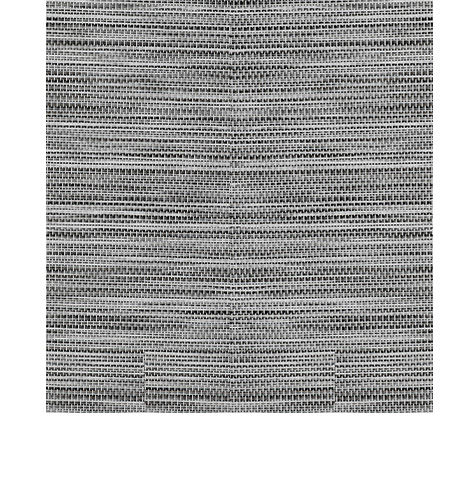Sunscreen blinds fabric, also known as solar blinds fabric or sunshade fabric, is a specialized type of fabric used in the manufacturing of window blinds. It is designed to provide protection against sunlight and glare while maintaining visibility and allowing natural light to enter the room. Here are some key characteristics and features of sunscreen blinds fabric:
Sunlight protection: Sunscreen blinds fabric is specifically engineered to block or reduce the amount of sunlight that enters a room. It helps to filter out harmful UV rays and minimize the impact of solar heat gain, keeping the interior space cooler and more comfortable. This makes it an effective solution for reducing solar glare and preventing the fading or damage of furniture, flooring, and other interior elements caused by prolonged sun exposure.
Light diffusion and visibility: Sunscreen blinds fabric is woven with an open mesh structure that allows diffused light to enter the room. Unlike blackout blinds or curtains that completely block out light, sunscreen blinds fabric maintains a level of visibility, enabling occupants to see outside while providing privacy during the day. The degree of visibility can vary depending on the fabric's openness factor, which refers to the percentage of open space in the fabric weave.
Energy efficiency: By reducing solar heat gain, sunscreen blinds fabric helps improve energy efficiency in buildings. By blocking a significant amount of sunlight, it reduces the need for air conditioning and helps to maintain a comfortable indoor temperature. This can lead to energy savings and contribute to a more sustainable and environmentally friendly environment.
UV protection: Sunscreen blinds fabric offers protection against harmful ultraviolet (UV) radiation from the sun. UV rays can cause damage to the skin, contribute to fading of interior furnishings, and even increase the risk of skin cancer with prolonged exposure. Sunscreen blinds fabric with a high UV protection factor (UPF) rating helps to block a significant portion of UV rays, providing an additional layer of protection for occupants and interior elements.
Durability and maintenance: Sunscreen blinds fabric is designed to be durable and resistant to fading, ensuring long-lasting performance. It is often made from polyester or a combination of polyester and PVC (polyvinyl chloride) materials, which are known for their strength, stability, and resistance to environmental factors. The fabric is typically easy to clean and maintain, requiring simple dusting or occasional gentle cleaning with a mild detergent.
Design and customization: Sunscreen blinds fabric is available in a variety of colors, patterns, and textures, allowing for customization to match different interior design styles and preferences. The fabric's aesthetic appeal, combined with its functional properties, makes it a popular choice for both residential and commercial applications.
Overall, sunscreen blinds fabric provides a balance between sun protection, visibility, and energy efficiency. It helps create a comfortable indoor environment by reducing glare, blocking UV rays, and regulating solar heat gain. Its versatility and customizable options make it a practical and attractive solution for controlling light and maintaining privacy while enhancing the overall aesthetics of a space.Besides,Sunscreen blinds fabric can be classified based on various factors, including material composition, openness factor, and functionality. Here are some common classifications of sunscreen blinds fabric:
Material composition:
a. Polyester fabric: Polyester is a common material used in sunscreen blinds fabric due to its durability, stability, and resistance to UV radiation. It is known for its strength and ability to withstand prolonged exposure to sunlight without fading or deteriorating.
b. Polyester/PVC blend: Some sunscreen blinds fabric combines polyester with PVC (polyvinyl chloride) to enhance the fabric's strength and stability. The PVC component adds extra resilience and resistance to environmental factors, making it suitable for long-lasting outdoor applications.
Openness factor:
a. High openness factor: Sunscreen blinds fabric with a higher openness factor allows more light to pass through and provides better visibility to the outside. It offers a clearer view while still providing sun protection and glare reduction. These fabrics typically have a more open weave structure with larger gaps between the fibers.
b. Low openness factor: Sunscreen blinds fabric with a lower openness factor has a tighter weave structure, reducing the amount of light and visibility. These fabrics offer increased privacy and improved sun protection, making them suitable for areas where privacy is a concern or for blocking out more sunlight.
Functionality:
a. Light filtering fabric: This type of sunscreen blinds fabric is designed to filter and diffuse sunlight, reducing glare while allowing a softened and diffused light to enter the room. It provides a balance between sun protection and maintaining visibility.
b. UV-blocking fabric: Sunscreen blinds fabric with enhanced UV-blocking properties provides increased protection against harmful UV radiation. These fabrics have a higher UPF (UV protection factor) rating, offering better safeguarding against UV rays that can cause skin damage and fading of interior elements.
c. Thermal insulation fabric: Some sunscreen blinds fabric incorporates thermal insulation properties, helping to regulate heat gain and loss. These fabrics have an additional layer or backing that provides insulation, improving energy efficiency and temperature control in the room.



 中文简体
中文简体 英语
英语 西班牙语
西班牙语







